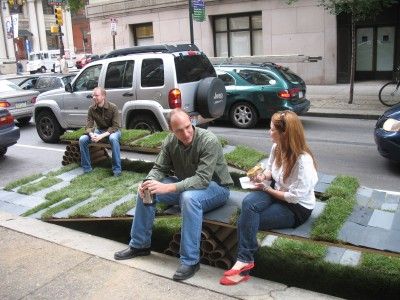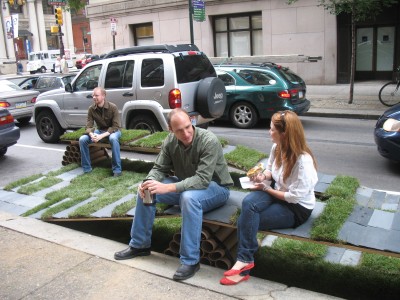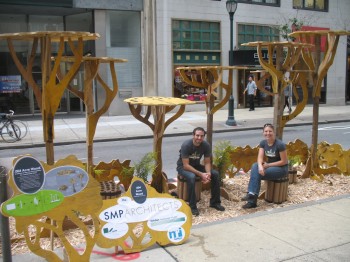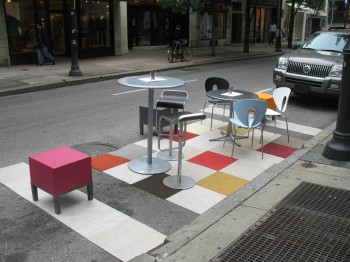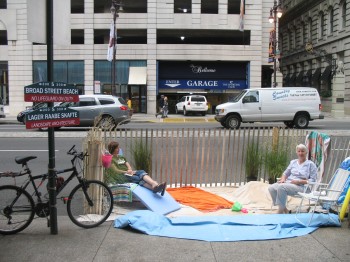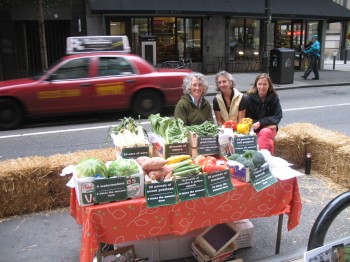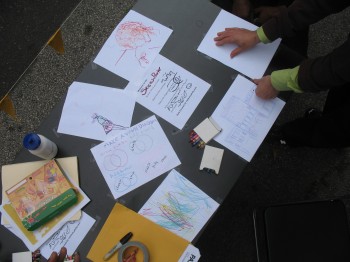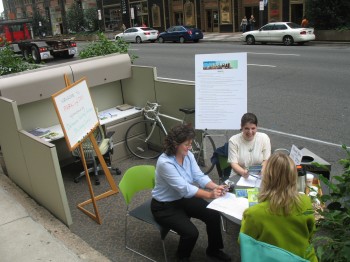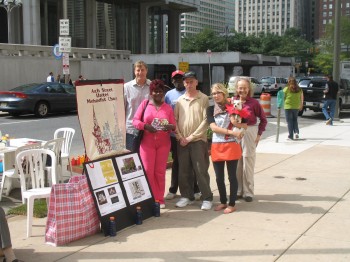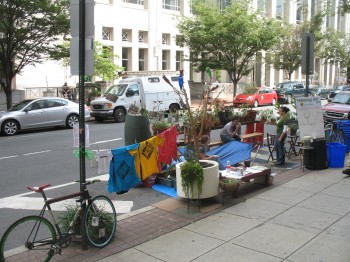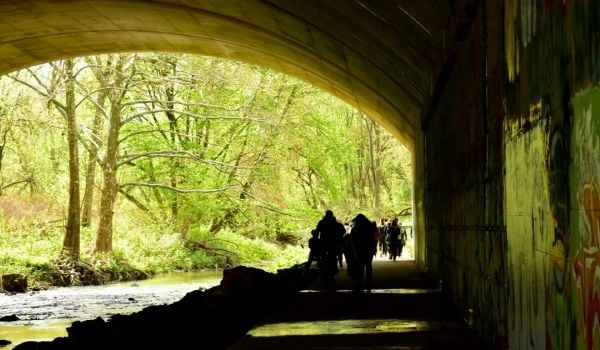Ever wonder what Philadelphia would look like if there were more park and recreational space? Last Friday, (September 18) you could. Ordinary city dwellers, design firms, community organizations and others took over metered parking spaces and turned them into temporary public parks for the second annual Park(ing) Day. This year over thirty-two different teams around Center City, University City and Manayunk/Roxborough signed on to dramatically increase the number of parks in Philadelphia for a day.
Park(ing) Day was established in 2005 by the San Francisco art collective Rebar. The day raises awareness about the decreasing amount of people-orientated public space in urban areas. By leasing a parking space for a day and dedicating its use to a non-vehicular purpose, Park(ing) Day gets people thinking about land use choices in cities. Park(ing) Day is now celebrated around the world but primarily in North America and Europe.
I spent Friday morning visiting and photographing Park(ing) sites in Center City close to City Hall. These are some of the sites I had a chance to visit:
Bohlin Cywinski Jackson – Broad and Walnut Streets
My Park(ing) journey began at the Bohlin Cywinski Jackson design firm site. Their park was located on the southeast corner of Walnut and Broad Street. The fact that the space could be seen from the firm’s 13th floor office across the street was considered when they were designing the park. The parking space was covered with two long benches that consisted of ply wood pieces covered with rubber roofing tiles. Strips of sod were added in-between tile pieces. This same pattern of rubber tiles and grass continued onto the ground of the parking spot. The benches were supported with pyramids of strapped cardboard tubes. “Everything from the micro-park is going to be reused,” Wolfram D. Arendt, an associate at the firm told me. “The bench and plywood will be used in our office, the grass sod will be returned to the supplier for reuse, the carpet [cardboard] tubes will be recycled and the [rubber] roofing titles will be installed on an actual roof.”
SMP Architects – 1600 block of Walnut Street
Cutouts of trees made out of wooden construction waste donated by Construction Waste Management provided shade in the SMP Architects Park(ing). Recycled cardboard plotter tubes were strapped together and placed upward so they could be used as stools underneath the trees. “We were trying to create an urban woodland,” Alexe Bosse and Ari Miller of the SMP Architects told me. The ground of the park was covered in mulch and the firm added several small plants towards the back of the space.The Park(ing) extended the sidewalk but had a definite, short wooden boundary that separated it from the street. All of the materials used in the design were byproducts of the construction industry and I was told all would be returned to the waste management company so the “construction cycle” would be continued and the wood could be turned into mulch.
Design Within Reach – 1700 block of Walnut Street
Design Within Reach leased a parking space right in front of their store on the 1700th block of Walnut Street. The open design of their park incorporated the store’s modern, metal inventory. The parking space was covered in a bright, multicolored rug, high chairs and tall tables. Scattered on the tables were crayons and pieces of paper. They hoped that people would use the space to create artwork and color and that the space would bring people in the store.
Lager Raabe Skafte Landscape Architects – Broad and Locust Streets
I headed back towards Broad and Locust Streets to visit Lager Raabe Skafte Landscape Architects’ site. The landscape architecture firm turned their space into a beach complete with sand and beach chairs. “We started with the Chill Chaise,” Julie A. Bush, a senior associate at the firm, told me as she pointed to a light blue, curving chair she was sitting in, “and then created the beach around it.” Bush explained that the chair was actually being used for one of their current park projects in Fairmount. The dune fence around the Park(ing) was from the beach and the plants and beach sand that completed the relaxing atmosphere of the space were from a hardware store.
Pennsylvania Planning Association Southeast Chapter – 16th and Arch Streets
In conjunction with the Greener Partners, the Pennsylvania Planning Association Southeast Chapter leased a parking space on 16th and Arch streets. The Park(ing) showcased the amount of fresh produce that could be cultivated within a single parking space. The two organizations placed a table full of fresh vegetables that displayed a small portion of what could be grown in the middle of their leased spot. I sat down on the haystacks that outlined the space and spoke to Erin Herz of Greener Partners and Cheryl Tumola of the Pennsylvania Planning Association about the space. They told me that a family could sustain themselves on a plot the size of their parking space, talked about the importance of environmental education and pointed out the eco-friendly equipment they had on display in the space.
VizThink Philadelphia – 1600 block of Chestnut Street
I spoke to Jonny Goldstein of VizThink Philadelphia about his organization’s Park(ing) SketchPark. The VizThink space was sectioned off from the street with rope and featured a single, large table and several chairs. Goldstein invited me to sit down and draw. He explained how VizThink encourages people to solve problems visually and showed me a sheet of suggested drawing themes that included drawing a dream vision of Philadelphia. There were already several drawings on the park’s table and I decided to contribute a terribly drawn, fictional urban landscape.
Delaware Valley Green Building Council – 1600 block of JFK Boulevard
“Unlike the other spaces, we are promoting green interior space,” said Sharon Roche, a member of the Delaware Valley Green Building Council when I visited the organization’s Park(ing). The Delaware Valley Green Building Council parking space was an open air, outdoor office. They had dragged out a cubicle, circular table and other office furniture. All of it, I was told, was either made from reused, recycled or remanufactured material. Their space was meant to demonstrate how easy it was to “green your own office.” In addition to handing out information about ways to create a more environmentally friendly office space, the Council was also trying to get people to sign their green office pledge.
Philadelphia City Planning Commission – 16th and Arch Street
The Philadelphia City Planning Commission leased a parking space on 16th and Arch Street for their tree “saplings,” made of wood, paper and anchored with plaster. R. David Schaaf, Director of Urban Design at the Planning Commission, and his team were inspired by William Penn’s dream of Philadelphia as a “greene Country Towne” and Joni Mitchell’s song “Big Yellow Taxi.” Each of the saplings were named after streets with tree names in Philadelphia. Three lines of Joni Mitchell’s song were chalked on the street: “ Don’t it always seem to go/ That you don’t know what you’ve got till it’s gone…/ Put ‘em in a tree museum.” The Commission hoped their design would raise awareness about the negative impact of paving and get people thinking about alternative, “smarter” surfaces that are more environmentally friendly. Like real baby trees, the saplings swayed when cars passed by.
Arch Street Methodist Church – 1400 block of Arch Street
The Arch Street Methodist Church’s site was made of two parking spaces and located right down the street from the Church. Members of the church were handing out postcards that were envelopes of wildflower seeds and invited those who passed by to attend a church service. After meeting the Pastor of the church I met the designer of the space, Susan. She told me that she had tried to create a place that people could hang out during their lunch break. The multicolored beverage containers, she pointed out, were meant to represent the diversity of the church’s congregation.
Center for Architecture, Community Design Collaborative, American Institute of Architects – 1218 Arch Street
Together the Center for Architecture, Community Design Collaborative and American Institute of Architects created a Park(ing) that included native plants from offices, borrowed outdoor furniture, a clothing line, recycled carpet tiles that were going to be returned to their manufacturers and makeshift shelves made from wooden joists salvaged from old buildings and orange construction barrels. Their park was meant to demonstrate how easy it is to live a “greener” lifestyle.
Duffield Associates, Inc. – 12th and Arch Streets
The last Park(ing) I visited was located across from the Pennsylvania Convention Center. Duffield Associates, Inc, the civil engineering firm behind the design of the micro-park, wanted to create a space where “lunchers” could come, sit, eat and learn about alternatives to shingle roofs. Thomas J. Halliwell, a civil engineer project manager at the firm, demonstrated the benefits of using a green roof as opposed to a regular tiled roof to those who passed by.

